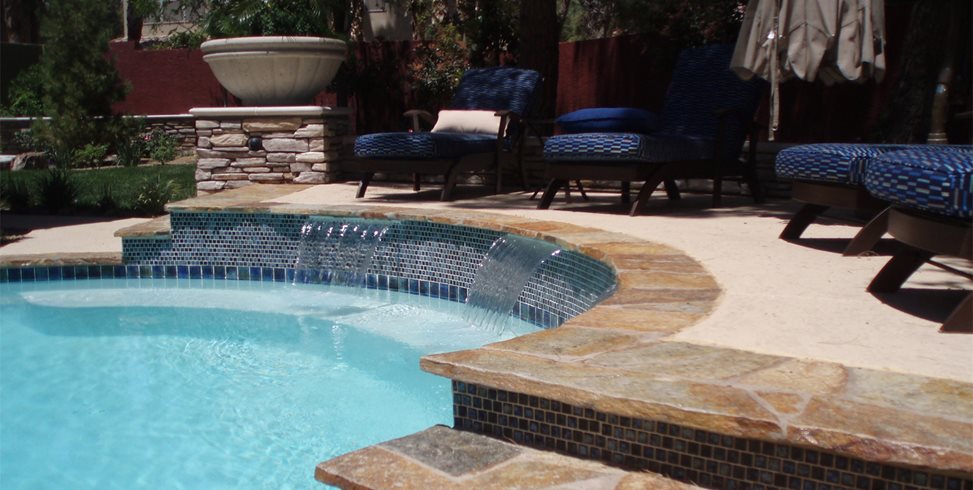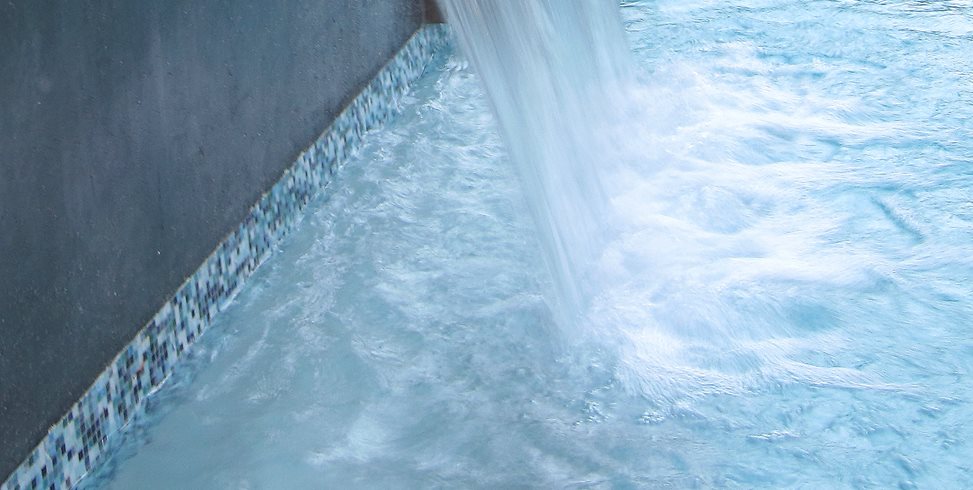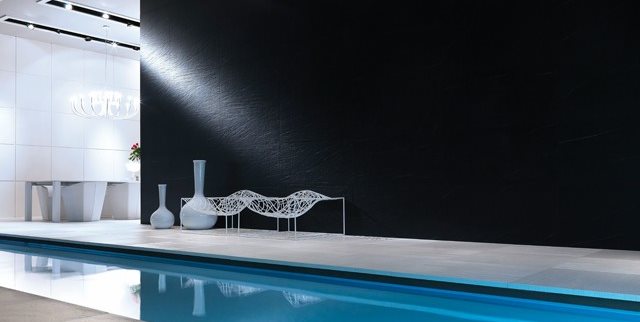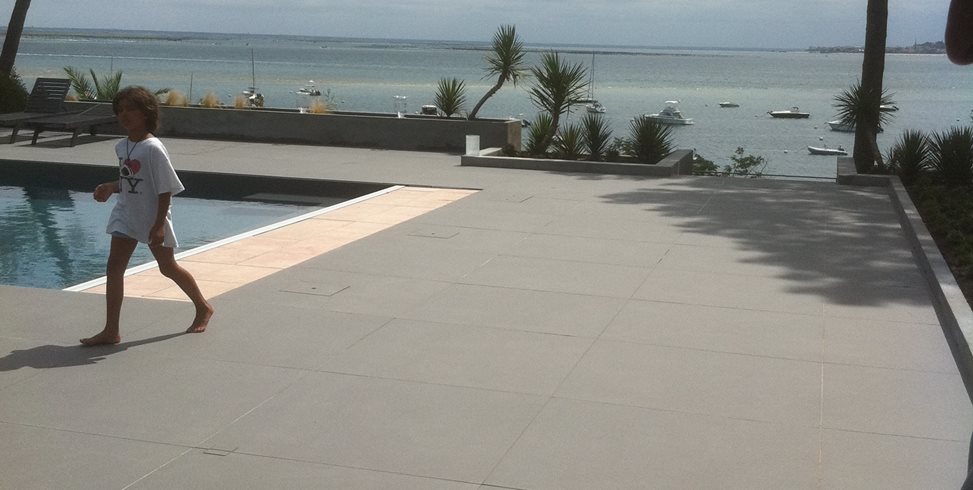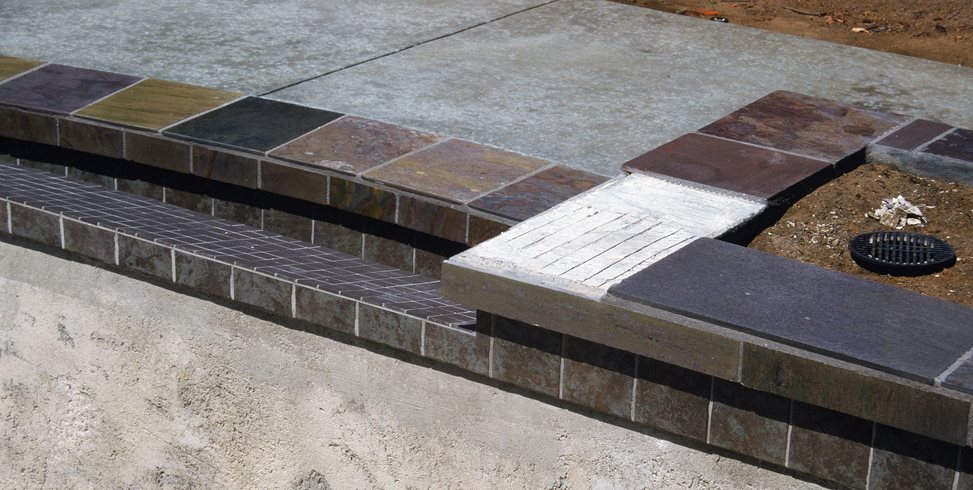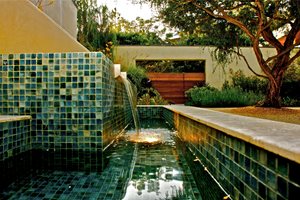Swimming Pool Tiles
Compare options for waterline tile including mosaics and Spanish motifsThe role of tile in swimming pools began exclusively at the water line, then expanded into a variety of different applications. As pool design evolved from simple rectangular pools of the 50s into more elaborate and highly engineered water features, tile integration has undergone a complete metamorphosis. Yet, despite such expansive changes, it's also returning to the 50s look upscaled with modern materials to suit ultra contemporary home design.
In pool projects, tile is used in these basic ways:
Waterline tile:
This strip of tile is placed beneath the coping along the water line.Coping:
The edge of the pool deck that overhangs the waterline tile.Raised Bond Beam:
Any time the pool shell or bond beam rises above the waterline, tile can be used to make that surface more attractive and maintenance free.Water features:
Since tile resists discoloration and adds beauty to a water feature, it is an aesthetic and practical way to make concrete walls more attractive by adding non-fading colors.Glass lined pool:
The luxury pool market is using glass tile to line the entire inside of a pool in lieu of traditional plaster.Ceramic tiles designated for swimming pools are their own exclusive category. Because pools contain heavily treated water and are exposed to freezing temperatures, these tiles must be specially manufactured for this purpose. Tile can make or break the look of your new swimming pool. When there is a raised bond beam that is faced with beautiful tile or where it's integrated into a pool water feature, this tile choice can become the pivotal material for your entire landscape aesthetic. It's the one thing you must get right in this expensive project.
Over the 20th century, styles of pool tile have gone through a few transitions, and each has taught lessons on what works and what doesn't and why. This points to one of the biggest problems, pool tile that becomes dated, and may become associated with passé architectural styles.
Tile Color
The earliest pools featured only aqua blue waterline tile with precast concrete coping units. In the 1960s Spanish style tiles became a popular way to add interest and color, but perhaps more importantly, the pattern disguised litter that often accumulates around the edges of the waterline. This era saw large 6x6 Spanish tiles give way to mosaics which broke up complex Spanish designs into smaller pieces. This tripled the amount of grout, and over time proved highly problematic. When grout failed, pieces of the mosaic could be broken or lost. The ability to replace those uniquely shaped and colored pieces depended on finding a source of that original tile. When the tile line went out of business, the only choice was to use a similar shaped piece from an available pattern. This demonstrates one of the most important factors relative to pool tile: avoid obscure lines that may not be available in the future.
The next tile trend was away from patterns altogether toward solid colors that worked well with newer dark bottom pools. A trend of hunter green or cobalt blue in the 1980s proved difficult to maintain. White mineral efflorescence showed up in stark contrast against the dark colored tiles demanding they be cleaned often. This caused even larger maintenance issues with tile rich water features first integrated into residential pools at this time. Many chose to return to blue waterline tile and manufacturers produced much wider range of shades and mottling to meet this need.
Today one trend is toward colors that remain neutral and blend into the overall design of pools and spas with dark bottoms, stone masonry and decks. Many of these tiles actually resemble stone in color and texture. Lansdcape architect Ive Haugeland's modern pools demonstrate this. "Our waterline tiles are more neutral, with white or neutral beige and glass. It's receding from view except for the glass, but even this is more neutral." The modern architectural designers are moving toward glass tile and turquoise water that can be integrated into creative night lighting. Glass, however, is vulnerable to scratching, so dense porcelain is proving the newest and most resilient new pool tile for both waterline and coping.
Glass Tile
The hottest new tile trend in luxury pools is glass tile, which are small square tiles that offer a clean iridescent look. "Glass tile isn't new but it's coming back around," says Chris Cipriano of Cipriano Landscape and Pool of New Jersey. "Most of our pools are finished with glass tile and pool bottom mosaics. Glass tile can be used in cold climates just as well as in warm ones. We line the entire pool shell tile for a very luxurious finish."
Alderete Lansdscape of southern California uses glass tile extensively, says Shea Alderete. "It's all in the installation. To do a whole pool in glass tile takes four weeks and a lot of craftsmanship to install. It's usually double what you think. We know what's involved so our pricing is fair, but the other guy may not and so his price is lower. They must use the right grout. Failure is typically the result of cutting corners with grout. Heat during the day and cold nights with shrinking grout leaves cracks and crevices and water gets into the gaps. Eventually the water expands and the tile pops. You need epoxy grout which is much more expensive, and that's why the low ball contractor's jobs are falling apart."
Porcelain Tile
Federico Martin, of Integral Renovation Projects considers porcelain tile a real problem solver where water is concerned. "When stone is used around swimming pools it is hot. Porcelain tile doesn't absorb heat and makes a good paving for pool deck and as waterline tile. Slate is hot, and the very thick larger sizes for modern design take 3 people to move and set each piece. Same size porcelain tile can be moved by one person and it's harder than stone and less brittle. Porcelain experiences zero % water absorption which means you don't get the efflorescence so common with stone. That makes it ideal for black colored reflecting pools."
Pool Contractors
Pool contractors in each state have their own preferred tile lines which are locally available and able to withstand the rigors of local weather conditions. From these a landscape architect can choose one that integrates into the overall palette of the pool and patio vision. One frequent mistake is to build a landscape piece meal, often due to budgetary constraints, by installing the pool before you hire a landscape designer for the rest of the yard. This makes tile choice somewhat arbitrary because there is no overall vision of the final materials palette. It is always better to design your yard with the pool in advance, then build it incrementally as time and budget permits.

 Backyards
Backyards
 Front Yards
Front Yards

